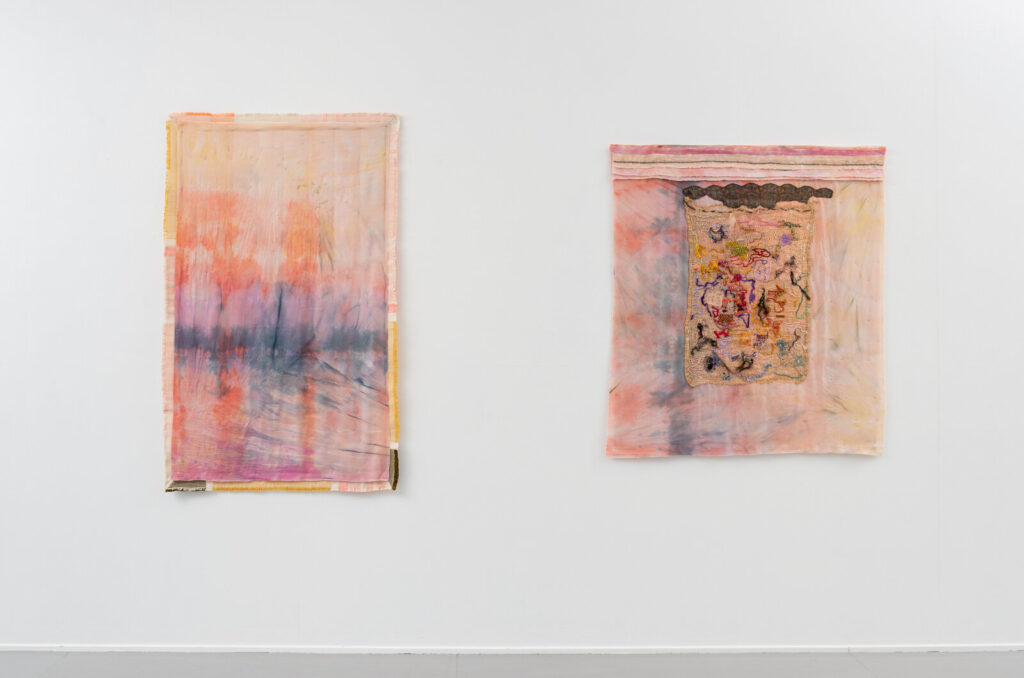In this exhibition they direct attention to their female ancestors. The histories and lifestyles of their grandmothers are processed through the works and brings new perspectives to our modern lifestyle.
Mørck shows three wall-hanged carpets. The titles of her works refer to traditional applied- and decorative textiles: “Navneduk” (sampler), “Bringeklut” (embroidered part of the national costume) and “Stolateppe” (a chair-blanket made of old bed sheets). The titles illuminate how textile handicraft and needlework were a considerable part of our ancestors’ lives. Mørck has not only examined their textile practice, but also looked at how it blended in between all the other tasks and duties of the day – Such as farm work or other paid work, domestic work and childcare.
Hand-to-hand knowledge is essential in Mørcks process. During conversations with her grandmothers, and her mother, she has learned needlework techniques and gained knowledge of the earlier generations of women’s lifestyle. The way they managed their resources and how they structured their days has served as a guideline in Mørck’s work.
In her work “Skogen til Besta” (“Grandmothers’ Forest”) Birkeland has gathered inspiration from her grandmother who lived as a farmer in a small village in western Norway. From her living room window she could look out on the valley, the village, the lake, the mountains, and the forest. She was gentle and compassionate, and worked carefully and conscientiously with the farm, the animals, the house, and the handcraft.
With a hairpin lace and a crochet needle one can make strips that normally are assembled together in shawls, blankets etc. At certain intervals the hairpin (or two parallel metal rods held at the top and the bottom by removable bars) is turned 180 degrees. That is why, when the strip is removed, it will twist around itself. If the hairpin lace is narrow, it can look like a DNA-string. If it is wide and fluffy, it can look like a type of lichen called Huldrestry. This hanging lichen that can become several meters long, mainly grows on old spruce forest, and is considered a critically endangered species in Norway.
Birkeland and Mørck held their first exhibition together at Osterøy Museum in 2019 and are currently also showing the exhibition “Hendene. Jorda.” (“The hands. The earth.”) at Hordaland Kunstsenter in Bergen.
Monika Mørck (b.1984, Trondheim) studied at Accademia Italiana, Firenze, and graduated with a Master of Arts from Oslo National Academy of the arts in 2013. She works thematically with topics related to female identity and –sexuality, in which are derived from her own life and experiences.
Mørck has, among other things, showed solo exhibitions at Bærum Kulturhus (2017), Soft Galleri (2016) and TM51 Infill (2015), participated at Trøndelagsutstillingen (2017 and 2020), STAUP Sculptural Biennale (2017) and a group show at Galleri F15 (2013).
Maia Birkeland (b. 1978, Førde) received her education at Oslo National Academy of the Arts and Glasgow School of Art, with a MFA in Medium- and Material Based Art from 2015. Birkelands’ work is centered around the constant influence between human – human, human – location, and location – human. Birkeland has, among others, held solo exhibitions at Trafo Kunsthall (2017) and Sogn og Fjordane Kunstmuseum (2017), and was festival artist for Førde Traditional and World Music Festival 2017. Her work has been shown at Janus Vestjylland Kunstmuseum in Denmark (2018), Vevringutstillinga 2017, Årsutstillingen 2015, and at Galleri F15 (2013).
Gallery name: Galleri Format Oslo
Address: Rådhusgaten 24 N-0151, Oslo
Opening hours: Tue-Fri 12:00 - 17:00, Sat-Sun 12:00 - 16:00
Open: 11.03.2021 - 27.06.2021







